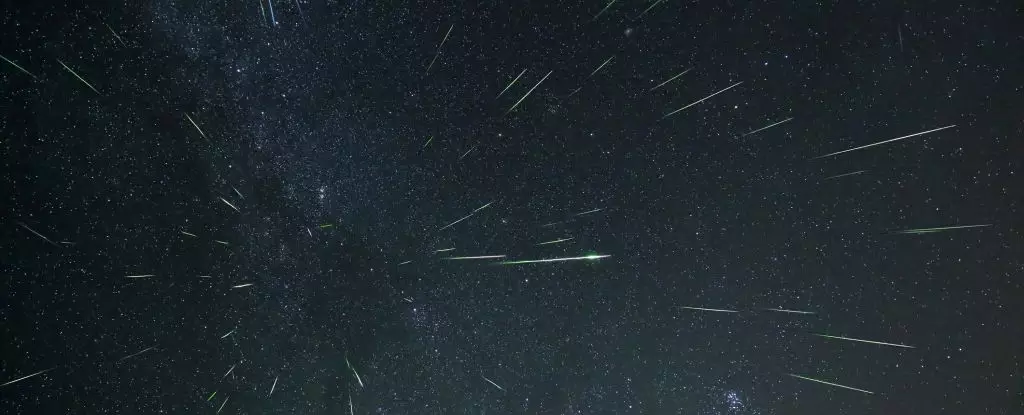As the vibrant month of April gracefully transitions into May, stargazers across the globe anticipate the breathtaking celestial phenomena known as meteor showers. This spring, the heavens will present two remarkable displays: the Lyrid meteor shower and the Eta Aquariids. While the Lyrids will span from April 17 to April 26, peaking on the nights of April 21 and 22, the Eta Aquariids will illuminate the skies from April 20 until May 21, peaking around May 2 and 3. These events serve as a reminder of the beauty of the universe and the grandeur of our place within it.
The best part? You don’t need a telescope or sophisticated equipment to enjoy this spectacle. A serene spot with a clear view of the night sky, along with your own eyes, will suffice. This accessibility invites everyone, from seasoned astronomers to casual viewers, to indulge in the ethereal beauty of shooting stars. However, the allure of these fleeting moments extends beyond the mere act of watching; it is an experience that elevates the human spirit and connects us to the cosmos.
Understanding the Science Behind Meteor Showers
Meteor showers may seem like random acts of celestial brilliance, but they are the result of an intricate cosmic dance. When Earth traverses through the debris trails left by comets or asteroids, our atmosphere collides with these minuscule particles. The ensuing friction ignites them, turning them into luminous streaks across the night sky. This astronomical phenomenon is not only a visual wonder; it’s steeped in science and the mechanics of our solar system.
The Lyrids, for instance, originate from Comet C/1861 G1 (Thatcher), which has an orbit lasting approximately 422 years. As we make our annual pilgrimage through the dust cloud left in its wake, we witness the remnants of its journey ignite and create a fleeting spectacle. Synonymous with the constellation Lyra, their radiant point brings together a mix of history and astronomy, reminding us of the poetic relationship between Earth and the vast universe.
Conversely, the Eta Aquariids are remnants of Comet 1P/Halley, popularly known as Halley’s Comet. With its captivating 76-year orbit, this comet has captured the imaginations of generations. The sky’s proximity to the constellation Aquarius during peak activity provides an excellent backdrop for viewing, especially in the southern hemisphere, where audiences are privileged to witness an extravagant display of up to 60 meteors per hour.
Optimal Viewing Conditions for Skywatchers
Timing is pivotal when it comes to witnessing meteor showers, as external factors can affect visibility. The Lyrid peak coincides with a waning moon this year, approximately 40 percent illuminated. This lunar presence creates challenges for visibility, as its glow can overshadow the fainter meteors. EarthSky recommends maximizing your viewing experience by positioning yourself away from city lights and preferably observing the night sky before moonrise on the evening of April 21. In the absence of significant lunar interference, you can expect to see 10 to 15 meteors per hour — a substantial number that speaks to the grandeur of these celestial events.
On the other hand, the Eta Aquariids promise a more generous offering, particularly for viewers situated in the southern hemisphere. With potential visibility of 50 to 60 meteors per hour, the spectacle allows for more leisurely skywatching. For those in northern regions, you may still glimpse up to 20 meteors, emphasizing that even partial experiences are well worth your time and effort.
Preparation for a Stellar Experience
To fully immerse yourself in the wonder of meteor showers, preparation can enhance your experience. Familiarizing yourself with reliable resources, such as Time and Date or the International Meteor Organization, can provide invaluable information tailored to your location. Knowing the optimal viewing times and conditions sets the stage for a truly remarkable evening beneath the stars.
As you prepare for these astronomical events, gather your friends or family, pack a cozy blanket or reclining chair, and cultivate your sense of anticipation. The simple act of lying back and gazing at the night sky, recounting dreams and wishes with each meteor streak, creates lasting memories that transcend the moment.
The upcoming Lyrid and Eta Aquariid meteor showers not only promise to be spectacular visual displays but also remind us of the boundless wonders of the cosmos. Amid our chaotic lives, they offer a perfect opportunity to connect with nature and reflect on our place in this vast universe. Every shooting star is an invitation to contemplate the extraordinary, urging us to remember that we are part of something immeasurably greater than ourselves. So, gear up for this celestial celebration; you won’t want to miss the chance to connect with the wonders of the universe.

